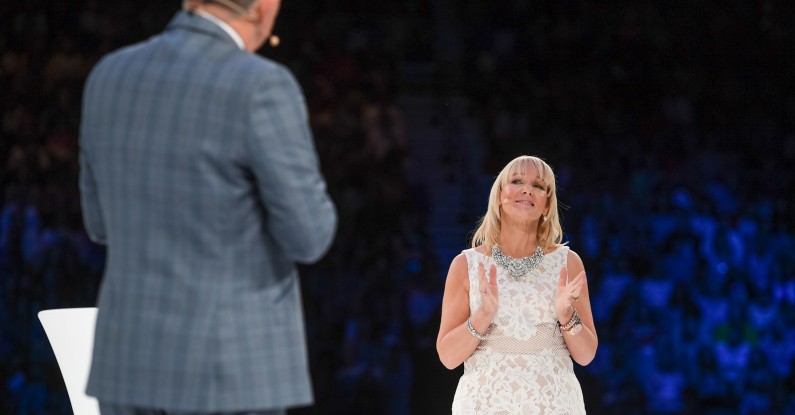
In May, I described the preparation of a presentation I made to over 16,000 delegates – the biggest live audience I’ve ever addressed.
My wife, Caroline, and I were speaking at the MGM Grand in Las Vegas to delegates from mainly the US, but also Canada, Australia, the UK and Poland, about becoming a global business leader.
By winning the hearts and minds of their team and clients through positive public speaking.
There were seven steps in our preparation:
After one final rehearsal backstage, we stepped out to our ‘walk on’ music – ‘500 Miles’ by the Proclaimers.
Having finished the preparation phase, it was now all about delivering the talk.
The noise was deafening as we walked the 30 yards of stage to the raised circle at the heart of the arena.
Many of the 1400 UK delegates were on their feet, clapping to the music – and we encouraged them all to join in with the unofficial Scottish anthem.
This was working.
We’d noticed that all the previous speakers had indulged in some banter or wise-cracking before launching into their formal presentation.
So we had a devised a couple of ‘ad libs’ – which were, of course, carefully scripted.
Now – as any public speaker would tell you – it’s time to execute the script, rather than consider the occasion.
That stops us worrying about how we’re being received by the audience.
So we concentrated instead on several key areas:
By far the most commonly-given piece of advice on our presentation skills training courses – run mainly from our Glasgow studios – is for participants to slow down.
There are several reasons people go too fast:
By slowing down, we create more impact in what we’re saying.
Why?
So in rehearsal for Las Vegas, we spoke at three words per second.
That’s the speed at which I learned to read the news for BBC and Scottish Television.
It’s accepted practice – because the audience can follow every word at that speed.
Tone is one of the most under-valued aspects of a successful presentation.
Consider the tremendous ability shown by actors reading excerpts from books and plays on radio (here’s one from Sir Michael Caine).
By ensuring that every single word is supported by exactly the right tone, they bring their story to life.
We do it most naturally in conversation – but in a formal presentation, tone can be lost to nerves and being caught up in the moment.
So we have to concentrate on tone in a more formal speech to get it right.
We have to think through the meaning of every word to ensure it’s matched by the appropriate tone.
When walking out in front of a large audience, we have to look upbeat.
The trick is to maintain a clear focus on positive body language throughout.
So we practised good body language in all those runs-through before entering the stage.
We used our hands naturally – rather than the manufactured way some news presenters and politicians today have adopted.
We often talk of ‘speaker’s stance’, which you’ll see in 90% of any TED talks.
Now let your hands express themselves and you’ll emphasise the point more clearly.
While impossible to make eye contact with 16,202 individuals, it’s essential to look to all corners of the arena.
So we practised in advance crossing the stage to address different parts of the auditorium.
The speech was on autocue at ground level.
So we used a technique I learned in TV.
Read the first part of the sentence from autocue, then look up to the audience and carry the second part of the sentence in your head.
You always come back to the autocue at the start of a new sentence, so it’s easier to keep your place.
It’s the same with any presentation.
Using this technique avoids any dead time when you’re silent and looking at your notes.
It’s a great way to keep your audience engaged throughout.
Regardless of how enthusiastic we think we’re being on stage, there’s always room for more enthusiasm.
I used to look back on what I thought had been highly-enthusiastic sports reports and presentations I’d done for TV, only to be disappointed in what I saw.
That’s because it felt great.
But what the audience experiences is something different.
For them to feel great, we have to be exceptional.
So Caroline and I kept building the enthusiasm throughout the presentation towards our key messages in the last minute of the piece.
We kept it slow – but we increased the enthusiasm – putting in all the energy we had.
Just after we walked off stage to a great ovation, I turned to Caroline and asked how she had enjoyed it.
Her reaction surprised me.
She started to cry.
She had simply given everything – and like an athlete at the end of the race of their life, she was empty.
In a good way.
Only if you have left everything on the stage do you know you’ve given your all.
So use these steps yourself, whether it’s a 1-1 with your colleague or an audience of 50,000.
And remember – our trainers are always here to help.
Bill McFarlan is managing director of media training and presentation skills training firm Pink Elephant Communications in Glasgow.
You can view his full profile here.
Photo credit: classic film scans via Foter.com / CC BY
5th August 2016 Featured in: Blog, Presentation skills training blogs, Public speaking training blogs By: Pink Elephant
Some media trainers knock you down…and leave you down. Our media coaches show you how to deal with each knock…and still win through. So you have the presentation skills to perform – with confidence.